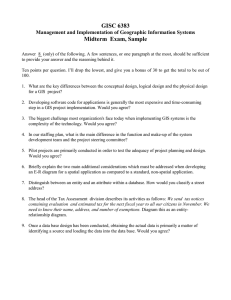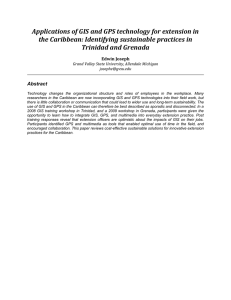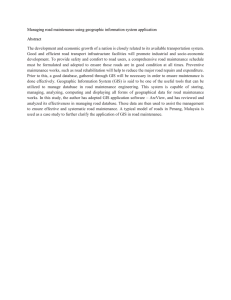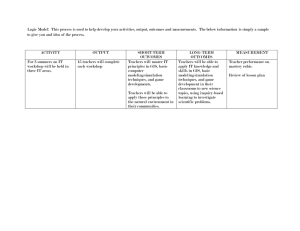UNSD Workshop Pieter van Jaarsveld Mobile GIS Specialist
advertisement
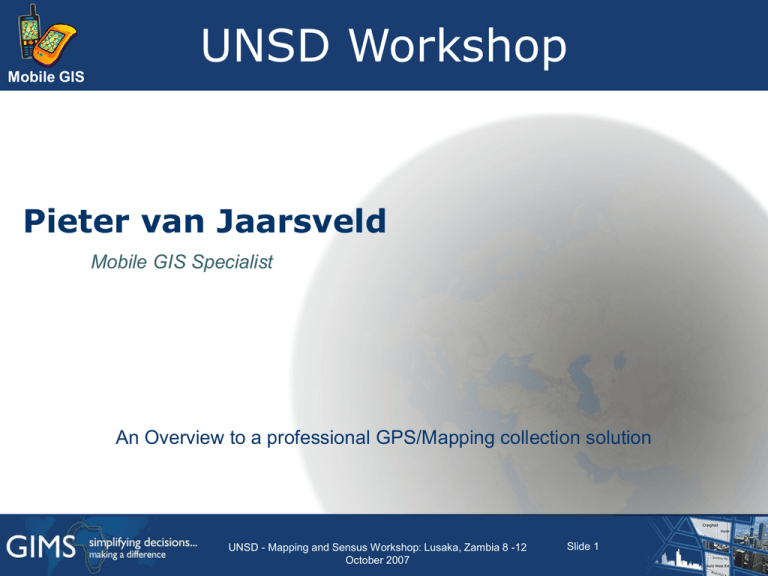
UNSD Workshop Mobile GIS Pieter van Jaarsveld Mobile GIS Specialist An Overview to a professional GPS/Mapping collection solution UNSD - Mapping and Sensus Workshop: Lusaka, Zambia 8 -12 October 2007 Slide 1 Mobile GIS Survey Recreational GPS users? In-car navigation users? Capturing GPS data in the field for GIS use? Plan to in the next year? UNSD - Mapping and Sensus Workshop: Lusaka, Zambia 8 -12 October 2007 Slide 2 Global Positioning System Mobile GIS UNSD - Mapping and Sensus Workshop: Lusaka, Zambia 8 -12 October 2007 Slide 3 Mobile GIS What is GPS? Global Positioning System • Where on earth am I ? Constellation of satellites Handheld devices Various Applications Accuracy UNSD - Mapping and Sensus Workshop: Lusaka, Zambia 8 -12 October 2007 Slide 4 GPS in 5 Basic Steps Mobile GIS 3 2 Use ephemeris for satellites’ location Accurate clocks are required 1 4 Correct for Atmosphere & Ionosphere 5 Differential Corrections Trilateration using speed of light UNSD - Mapping and Sensus Workshop: Lusaka, Zambia 8 -12 October 2007 Slide 5 Mobile GIS UNSD - Mapping and Sensus Workshop: Lusaka, Zambia 8 -12 October 2007 Slide 6 Mobile GIS Control Segment Provides worldwide coverage and control • 365/24/7 Master Control station • Colorado Four support stations • • • • Hawaii Kwajalein Diego Garcia Ascension Island UNSD - Mapping and Sensus Workshop: Lusaka, Zambia 8 -12 October 2007 Slide 7 Mobile GIS Space Segment GPS satellite constellation • 24 satellites • Replenishment occurring Satellite design 12 10 Number • Lifetime 7.3 years • 16 satellites over 9 years old 28 Satellites in GPS Constellation 8 6 4 2 0 Under 3 3-4 5-6 7-8 9-10 Age (Years) UNSD - Mapping and Sensus Workshop: Lusaka, Zambia 8 -12 October 2007 Slide 8 11-12 13+ Mobile GIS User Segment Equipment produced by Military and Private companies Receives signal and computes • Position • Time • Velocity UNSD - Mapping and Sensus Workshop: Lusaka, Zambia 8 -12 October 2007 Slide 9 How do we position ourselves? Mobile GIS Simple Geometry • Velocity times vs travel time Determine Radio Wave Time Travel • Accurate timing Measure Distances • Known orbit locations Trilateration • Distances not angles UNSD - Mapping and Sensus Workshop: Lusaka, Zambia 8 -12 October 2007 Slide 10 Sources of Positioning Error Mobile GIS Ionosphere and Atmospheric delays Satelite and receiver Clock Error Multipathing Dilution of Precision Receiver Issues Selective Availability UNSD - Mapping and Sensus Workshop: Lusaka, Zambia 8 -12 October 2007 Slide 11 Mobile GIS • • Two receivers track the SAME signals and errors at the SAME time Derived corrections are then applied to the data during postprocessing – • Differential GPS GPS Analyst contains tools for DC Does not correct multipath Data Collector Base UNSD - Mapping and Sensus Workshop: Lusaka, Zambia 8 -12 October 2007 Slide 12 Mobile GIS Differential Correction Red = Uncorrected GPS Green = GPS after differential correction UNSD - Mapping and Sensus Workshop: Lusaka, Zambia 8 -12 October 2007 Slide 13 Mobile GIS Selecting a GPS Recreational versus Professional GPS Accuracy • Tens of meters versus sub meter GIS data integration • Format conversion Attribute collection • Customised forms, business rules UNSD - Mapping and Sensus Workshop: Lusaka, Zambia 8 -12 October 2007 Slide 14 Mobile GIS Data Collection Software UNSD - Mapping and Sensus Workshop: Lusaka, Zambia 8 -12 October 2007 Slide 15 Data Collection Workflow Mobile GIS Server (server to server) Desktop Mobile Export to PGDB Enterprise Geodatabase Check out Copy to device Server Desktop Copy to Desktop ArcPad Check In Data validation Post process UNSD - Mapping and Sensus Workshop: Lusaka, Zambia 8 -12 October 2007 Import to Enterprise Slide 16 Mobile GIS Data - things to remember Check out and post processing is performed on a personal geodatabase NOT directly from enterprise. WHY? •GPS detail not required in enterprise •Topology not supported in GPS Analyst Carefully choose extents. WHY? •Large extent limits the amount of data capture Current only personal geodatabase support, efforts to supporting file geodatabase underway. UNSD - Mapping and Sensus Workshop: Lusaka, Zambia 8 -12 October 2007 Slide 17 UC 2007 Tech Sessions 17 Mobile GIS What is ArcPad? •Part of ESRI overall mobile strategy •A mobile GIS application for field mapping applications •Designed for broad range of mobile systems •Allows input from GPS receivers, rangefinders, digital cameras and other devices •Provides a generic set of mobile GIS functionality •Extensive customization capabilities •Extends Geodatabase to the field through disconnected editing UNSD - Mapping and Sensus Workshop: Lusaka, Zambia 8 -12 October 2007 Slide 18 What can you do with ArcPad? Mobile GIS • • • • • • • • Use your existing data Add data from the Internet Move around your map Query your data Edit your data Measure distance, area, and bearings on your map Navigate with your GPS Customize ArcPad to streamline your workflow UNSD - Mapping and Sensus Workshop: Lusaka, Zambia 8 -12 October 2007 Slide 19 Mobile GIS ArcPad Benefits Streamlines the workflow • Smart, task oriented solutions Increases productivity • Reduces office work and data entry time • Improves the accuracy of data • Resulting in more accurate and current data for analysis and decision making UNSD - Mapping and Sensus Workshop: Lusaka, Zambia 8 -12 October 2007 Slide 20 Mobile GIS ArcPad Functionalities Improved performance Enhanced editing tools • Snapping • Undo • offsets for points, lines, polygons • repeated features • segmented line features Camera and rangefinder support Improved symbology and labeling Support for Graphics layer • for redlining or mark-up Import/export tools for ArcGIS Customization • wizard for creating custom forms UNSD - Mapping and Sensus Workshop: Lusaka, Zambia 8 -12 October 2007 Slide 21 Mobile GIS ArcPad Functionalities Significant performance gains on startup time • Pre-buffering input • Affects Applets, Layers, Scripts etc. (i.e ALL XML and Scripts) • Delayed loading of projection data Usability enhancement • Datum conversion wizard • Picture browsing capabilities on Windows Mobile 5 devices • Additional language packs available Quality improvements • About 80 bugs have been identified and fixed! Minor feature improvements • Object model improvements (Picture chooser, File object , Inter-process methods) UNSD - Mapping and Sensus Workshop: Lusaka, Zambia 8 -12 October 2007 Slide 22 Mobile GIS Configuring the GPS Protocol = “Trimble GPSCorrect” or “NMEA0183” Port = “COM3: TSIP Serial Port (GeoExplorer) Port = “COM7: TSIP Serial Port (JunoST) Port = “COM2: TSIP Serial Port (Recon XC) UNSD - Mapping and Sensus Workshop: Lusaka, Zambia 8 -12 October 2007 Slide 23 Mobile GIS Streaming and Averaging Averaging number of incoming GPS position coordinates that ArcPad uses for calculating an average coordinate Streaming Position Interval = How frequently ArcPad uses incoming GPS coordinates Distance Interval = ArcPad uses incoming GPS coordinates only when greater than this distance from LAST coordinate used UNSD - Mapping and Sensus Workshop: Lusaka, Zambia 8 -12 October 2007 Slide 24 Mobile GIS GPS Preferences Quality Minimum and maximum values can be predefined Can be made compulsory to ensure data integrity Warning and Alerts Visual and Audio alerts Constantly warns the user if not complying to presets Will inform the user of GPS status Can be annoying Can be switched off UNSD - Mapping and Sensus Workshop: Lusaka, Zambia 8 -12 October 2007 Slide 25 Mobile GIS Editing using the GPS Firstly, make layer editable (one point, line, polygon, at a time) Then select feature type UNSD - Mapping and Sensus Workshop: Lusaka, Zambia 8 -12 October 2007 Then select GPS capture tool Slide 26 Mobile GIS Ensuring data quality Elevation Mask Default 15 No. of Satellites Min of 4 SV’s SNR Signal to Noise Ratio DOP High = Accurate Low = Productive SV Geometry High = BAD Low = GOOD UNSD - Mapping and Sensus Workshop: Lusaka, Zambia 8 -12 October 2007 Slide 27 UC 2007 Tech Sessions 27 Mobile GIS ArcPad with other devices ArcPad can be used with: • Digital Cameras • WiFi enabled cameras • BT enabled camerasUse “Camera” tool • Photo Layer • Custom Form • Laser Rangefinders • What is your accuracy needs? • External GPS UNSD - Mapping and Sensus Workshop: Lusaka, Zambia 8 -12 October 2007 Slide 28 Mobile GIS Data Collection Techniques Where are the Satellites? • Your Body is an obstruction! Point Data Collection • Position First and Attributes Second Polyline & Polygon Collection • Streaming (less accurate but dynamic) • Vertex Averaging (more accurate and static) UNSD - Mapping and Sensus Workshop: Lusaka, Zambia 8 -12 October 2007 Slide 29 UC 2007 Tech Sessions 29 Mobile GIS ArcPad Tips and Tricks •Do you understand Sticky Keys? •Have you used appropriate colours and line thicknesses? •Is your device locked? •Don’t you pick on me! (Avoid clicking on the map) •The art of using a stylus •Slow down and smell the flowers! UNSD - Mapping and Sensus Workshop: Lusaka, Zambia 8 -12 October 2007 Slide 30 UC 2007 Tech Sessions 30 Mobile GIS ArcPad Orientation Demonstration UNSD - Mapping and Sensus Workshop: Lusaka, Zambia 8 -12 October 2007 Slide 31 Mobile GIS Thank you Mobile GIS Specialist pvanjaarsveld@gims.com (011) 238 6300 UNSD - Mapping and Sensus Workshop: Lusaka, Zambia 8 -12 October 2007 Slide 32
